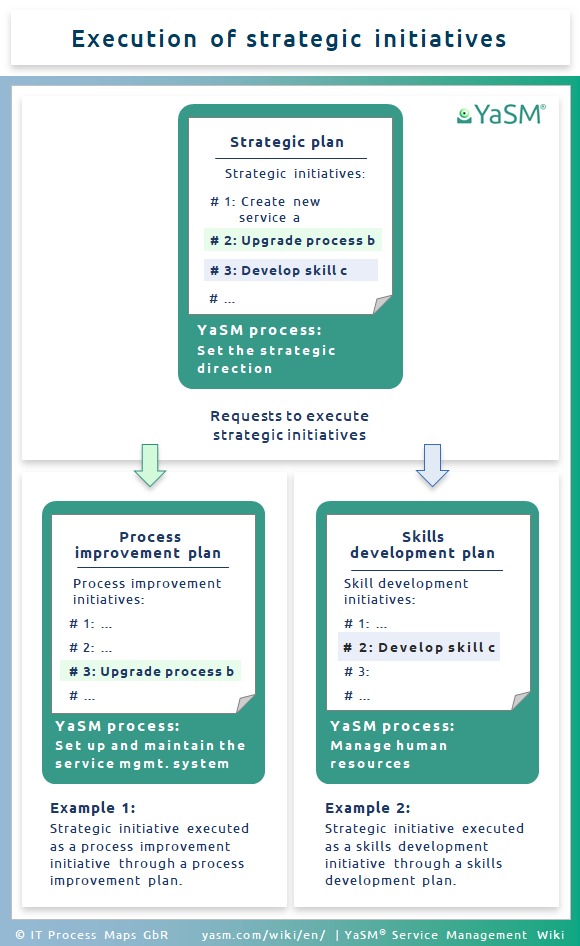Plans for organizing Service Management Initiatives
If services, their underlying components or parts of the SMS need to be set up or modified, YaSM recommends organizing such work as initiatives (e.g. strategic initiatives, service improvement / process improvement initiatives etc.) managed through a number of plans.
Part of: Service management concepts
Previous concept: Customer vs. operational service definitions and agreements
Types of service management plans
YaSM suggests to maintain the following service management plans:
- Strategic plan
- The strategic plan is owned by the steering committee and maintained by the service strategy manager. Its purpose is to manage strategic initiatives, i.e. initiatives aimed at achieving the strategic objectives. Typical examples are the development of new or significantly changed services or service management processes, or the introduction of new technologies or capabilities on a larger scale.
- Service improvement plan
- The service improvement plans are owned by the service owners. Their purpose is to manage service improvement initiatives, i.e. initiatives of a somewhat smaller scale aimed at continually improving existing services. A typical example is an infrastructure enhancement to improve service availability.
- Process improvement plan
- The process improvement plans are owned by the process owners. Their purpose is to manage initiatives aimed at setting up or improving the service provider's processes (which are an important part of the service management system). A typical example is an upgrade to the incident resolution process.
- Security improvement plan
- The security improvement plan is owned by the security manager. Its purpose is to manage initiatives aimed at improving security. For such improvements, it is often impractical to execute them as service improvement initiatives because several services are affected. A typical example is the introduction of a new malware detection system.
- Continuity improvement plan
- The continuity improvement plan is owned by the service continuity manager. Its purpose is to manage initiatives aimed at improving service continuity in the case of disaster events. For such improvements, it is often impractical to execute them as service improvement initiatives because several services are affected. A typical example is an upgrade to a stand-by data center.
- Skill development plan
- The skill development plans are owned by the human resources manager. Their purpose is to manage the development of the skills required in the service provider organization. A typical example for an item in the skills development plan is a training program aimed at acquiring the necessary skills for mastering a new technology.
The various service management plans play a central role in getting the initiatives approved and funded, and also in tracking their status. For example, a new strategic initiative is first entered into the strategic plan as a proposal. The steering committee then needs to approve the initiative, which in turn allows the initiative's owner to obtain funding by submitting a budget request. While it is being implemented, the initiative's status information in the strategic plan is constantly updated.
Depending on their scale, some initiatives will be carried out as formal projects, while others will be executed in an informal way.
Execution of strategic initiatives
Because the strategic process defines a number of strategic initiatives but does not normally have the resources to carry them out, the strategic plan often functions as a top-level plan, as shown in the figure on the right.
In this respect, YaSM allows for strategic initiatives to be executed for example as:
- Service improvement initiatives managed through a service improvement plan
- Process improvement initiatives managed through a process improvement plan
- Skill development initiatives managed through a skills development plan.
Suggestions for strategic initiatives
It is also possible that issues are identified during service reviews which point to problems whose resolution is beyond the scope of "ordinary" service improvements (for instance a perceived gap in the service portfolio).
In such cases it will be appropriate to submit suggestions for strategic initiatives to the strategic process.
Notes
By: Andrea Kempter ![]() and Stefan Kempter
and Stefan Kempter ![]() , IT Process Maps.
, IT Process Maps.
Types of service management plans › Execution of strategic initiatives › Suggestions for strategic initiatives






